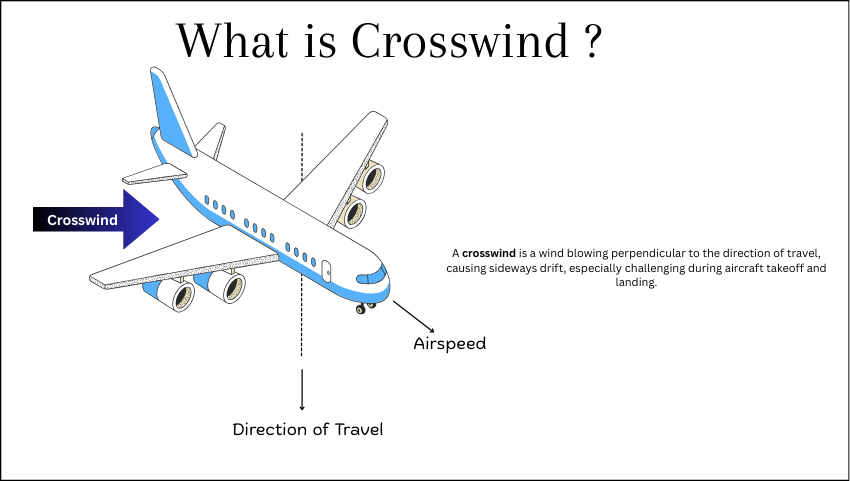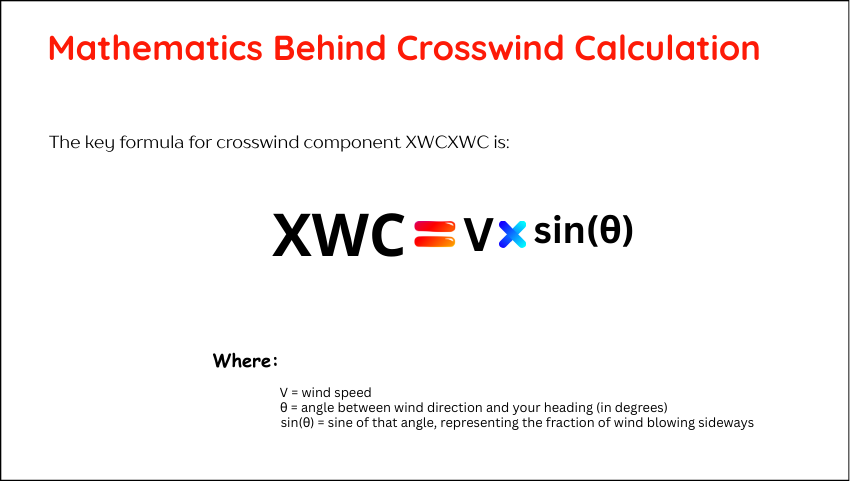Professional Crosswind Calculator
Advanced aviation wind component calculator with comprehensive aircraft limits
📊 Understanding Wind Components
Crosswind Component: The perpendicular wind component to the runway centerline, calculated using the sine of the wind angle. This is critical for aircraft control during landing and takeoff, as it affects lateral drift and required rudder input.
Headwind/Tailwind Component: The parallel wind component along the runway, calculated using the cosine of the wind angle. Headwinds reduce ground roll and improve climb performance, while tailwinds increase landing distances and reduce climb rate.
Wind Angle: The angular difference between wind direction and runway heading (0-180°). This determines the relative magnitudes of crosswind and headwind components.
Aircraft Limits: Configure maximum crosswind and tailwind limits specific to your aircraft type, weight, and pilot proficiency. The calculator provides visual and numeric warnings when operational limits are exceeded.
Safety Note: Always consult your aircraft's POH/AFM for official limitations. Weather conditions, runway surface, and pilot experience significantly affect actual operational limits.
Flying an aircraft or driving in windy conditions often brings challenges. One of the key factors pilots and vehicle operators need to understand is crosswind—wind blowing across their path, not directly head-on or behind. Knowing how to measure and calculate this crosswind component is crucial for safety and successful navigation.
A crosswind calculator is a helpful tool that lets you figure out how strong the sideways wind component is relative to your direction of travel, such as the runway direction in aviation or vehicle heading on the road.
What is Crosswind?
When wind blows, it can hit you from any direction. The wind has components:
- Headwind or tailwind: Wind blowing directly against or behind your direction.
- Crosswind: Wind blowing from the side, perpendicular or at an angle to your direction.

A crosswind affects how an aircraft or vehicle behaves. For airplanes, it influences takeoff, landing, and taxiing safely on a runway. For drivers, strong crosswinds can push the vehicle sideways, requiring careful steering.
Crosswinds are often unavoidable, but knowing their strength helps you adjust your angle, speed, or approach safely.
Why Use a Crosswind Calculator?
Knowing the exact strength of the crosswind component gives pilots and drivers important insights.
- In aviation, it helps decide the best runway to use based on wind direction.
- It tells if the crosswind is within safe limits for takeoff and landing.
- It assists in making real-time flight path corrections.
- For drivers, it helps anticipate the vehicle’s response and stay safe.
Using a crosswind calculator improves safety and performance by quantifying the sideways wind strength accurately rather than guessing.
How Does a Crosswind Calculator Work?
A crosswind calculator takes into account:
- Wind speed — the strength of the wind (in knots, mph, or km/h).
- Wind direction — where the wind is coming from (degrees on a compass).
- Your heading or runway direction — the direction you are moving toward or the runway orientation.
The calculator then uses basic trigonometry to split the wind into components:
- The headwind/tailwind component (along your direction).
- The crosswind component (perpendicular to your direction).
The Mathematics Behind Crosswind Calculation
The key formula for crosswind component XWCXWCXWC is XWC=V×sin(θ).

Where:
- VVV = wind speed
- θ\thetaθ = angle between wind direction and your heading (in degrees)
- sin(θ)\sin(\theta) sin(θ) = sine of that angle, representing the fraction of wind blowing sideways
Similarly, the headwind/tailwind component is:HWC=V×cos(θ)HWC = V \times \cos(\theta)HWC=V×cos(θ)
Where cos(θ)\cos(\theta)cos(θ) is the cosine of the angle showing wind strength aligned with travel direction.
This trigonometric method is the most accurate way to calculate.
Simple Methods to Calculate Crosswind—Without Complex Math
Not everyone wants to pull out a calculator or remember sine and cosine values. Luckily, there are simple mental methods pilots often use that give a close approximation quickly.
1. Clock Face Method
Imagine the angle difference like the minutes on a clock.
- 15° difference = crosswind is about ¼ of wind speed
- 30° difference = crosswind is about ½ of wind speed
- 45° difference = crosswind is about ¾ of wind speed
- 60° or more = crosswind almost equal to wind speed
Example:
If wind speed is 20 knots blowing 45° off your runway, the crosswind is roughly 15 knots (¾ of 20).
2. Percentage Estimation (Easy Percentages)
This method estimates crosswind percentage by the angle:
- 0° to 20° = 0% (almost no crosswind)
- 20° to 40° = 50% of wind speed
- 40° to 50° = 70% of wind speed
- 50° to 70° = 90% of wind speed
- 70° to 90° = 100% of wind speed
Multiply the percentage by the wind speed for the crosswind component.
3. Divide by Ten Method for Quick Calculations
A popular mental method among pilots:
- Divide wind speed by 10
- Find difference between runway and wind direction
- Add 2 to the difference
- Multiply the result by the divided wind speed
This results in an approximate crosswind speed.
Example: Runway heading 230°, wind from 200° at 14 knots
- 14÷10=1.414 ÷ 10 = 1.414÷10=1.4
- Difference = 230−200=30230 – 200 = 30230−200=30, add 2 gives 32
- 32×1.4=44.832 \times 1.4 = 44.832×1.4=44.8 (This example needs context for more accurate steps; the idea is a quick mental estimate.)
Using Electronic Crosswind Calculators
Today, many pilots and drivers rely on electronic crosswind calculators, apps, or built-in avionics. You just input
- Wind speed
- Wind direction
- Your heading or runway number
and the calculator instantly gives you crosswind and headwind components.
These electronic tools improve efficiency and reduce errors, especially under pressure.
Practical Example of Crosswind Calculation
Let’s say your runway heading is 090° (due east) and the wind is blowing from 120° at 25 knots.
- Calculate the difference in angle:
∣120°−90°∣=30°|120° – 90°| = 30°∣120°−90°∣=30° - Using the sine approximation:
sin(30°)=0.5\sin(30°) = 0.5sin(30°)=0.5 - Crosswind component:
25×0.5=12.525 \times 0.5 = 12.525×0.5=12.5 knots
This means 12.5 knots of wind is pushing across your path.
Understanding Crosswind Limits for Aircraft
Every aircraft has a maximum demonstrated crosswind component—the highest crosswind the manufacturer tested the aircraft to handle safely during landing.
Pilots must know this limit to avoid unsafe takeoffs or landings. For example:
- Light aircraft might have limits around 10-15 knots.
- Larger commercial planes often have higher limits but still must respect them.
If the calculated crosswind exceeds this limit, pilots should consider alternate runways or delay.
Additional Factors Affecting Crosswind
- Gusts: Sudden changes in wind speed can increase crosswind unpredictably.
- Wind shear: Rapid changes in wind direction can cause instability.
- Terrain: Mountains or buildings can cause turbulence, affecting wind impact.
Crosswind calculators provide a component estimate, but awareness of these factors is key.
Frequently Asked Questions
What is a crosswind calculator?
A crosswind calculator is a tool used to find the sideways (crosswind) and headwind components of the wind relative to your direction of travel, usually for aviation or driving. It helps measure how much wind is pushing you from the side.
Why is calculating crosswind important?
Calculating crosswind is important for safety as it affects aircraft takeoffs, landings, and vehicle stability. Knowing crosswind strength helps make better decisions to avoid accidents and control movement better.
What inputs do I need for a crosswind calculator?
You need three main inputs: wind speed, wind direction (where the wind comes from, in degrees), and your direction or runway heading.
Can I calculate crosswind without a calculator?
Yes! Pilots often use simple methods like the clock face method or rough percentage estimates to mentally approximate crosswind quickly without complex math.
Summary and Final Tips
- Crosswind calculators help break wind into side (crosswind) and front/back (headwind/tailwind) components for safer flights or driving.
- The essential inputs are wind speed, wind direction, and your heading/runway direction.
- Use trigonometry for precise calculations.
- Simple methods like the clock face or percentage estimation work well for quick mental calculations.
- Know your vehicle or aircraft’s crosswind limits for safety.
- Consider gusts and wind shifts — calculations show a moment’s estimate, not real-time changes.
- Electronic crosswind calculators simplify and speed up decision-making.
